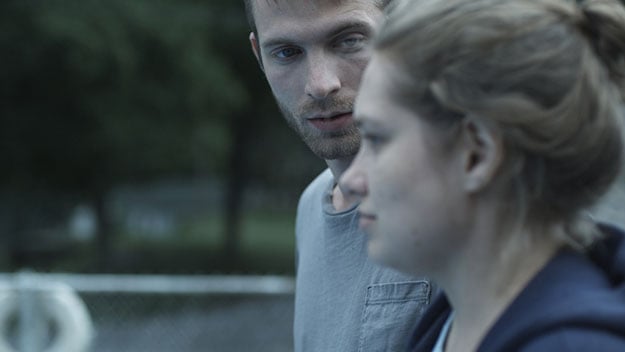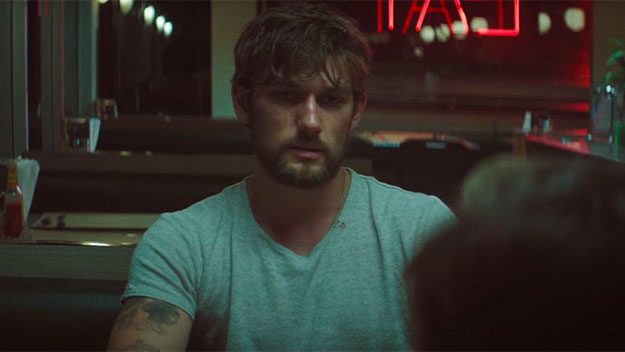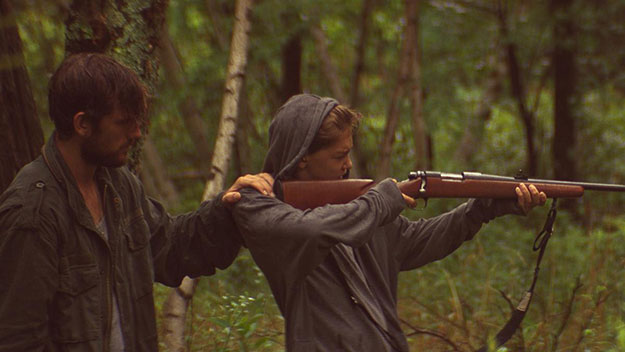Deep Focus: The Strange Ones

The movie-brat generation established the tradition of directors using short films as calling cards—most famously, George Lucas with Electronic Labyrinth: THX 1138 4EB (1967), which he expanded into THX 1138 (1971), and Steven Spielberg with Amblin’ (1968), which helped win him a deal at Universal’s TV division (and later supplied the name to his production company). But in the case of Christopher Radcliff and Lauren Wolkstein, their 14-minute short The Strange Ones (from 2011) has the impact of a stand-alone work of art, while the 81-minute feature, which made the festival circuit last year and is just now being released, feels more like the show-off calling card.
In the incident common to both stories, a barely adolescent boy and an alternately gruff and solicitous man, probably in his twenties, leave their broken-down car by the side of a rural road and stumble on a lonely motel. The lad strips off his shirt and jumps in the pool, while his grown companion tells the motel’s female manager that they’re brothers on a road trip. She offers to help, but when she and the boy are left alone, he plants the idea that his liar “brother” could rob or kill or rape her. She takes these horrifying words as nothing more than teenage bravado until the pair rushes away without a word.
The short tells a neat little open-ended horror tale about the ambiguity of appearances. How can we trust the evidence of our senses without a storyteller (or a reporter or a cop or a friend) putting it in a proper frame? Each time I’ve watched this curt, evocative anecdote it’s left me fraught and fascinated. The efficient, unvarnished style and the guys’ skillfully masked or stoic acting fill us with dread while leaving almost all our suspicions quivering in an electric atmosphere.

From the start, the feature version fills in the premise that the short more fruitfully leaves obscure. We understand right away that this odd couple has been on the run: the boy flashes back to a vision of a house burning to the ground and his partner spiriting him away from it. The relationship comes quickly into focus. As they share the front seat, Sam (James Freedson-Jackson), the boy, offers his companion, Nick (Alex Pettyfer), a bite of his sandwich in a gesture that’s easy and intimate but more flirtatious than brotherly. (I suppose they could be incestuous siblings.) The camera holds on the man’s face as he watches the teen’s bare back as it slides into the pool; a flashback depicts the boy spying on the man as he masturbates in a shower.
When the young ’un blows the whistle on Nick to the motel manager, Kelly (Emily Althaus), he talks to her in bald sexual terms. He tells her that his traveling pal is gay, goes limp with women, and considers her an “idiot” who’d do anything he wants. With these performers milking every moment for “feeling” and “meaning,” the emotional dynamics become stunningly obvious. (I prefer the drier performances in the short, which features David Call as “Man,” Tobias Campbell as “Boy,” and Merritt Wever as “Girl.”) It’s as if the writing-directing team of Radcliff and Wolkstein had repurposed their original work to display their own mood-setting talents in a string of beautifully judged shots —and a series of self-congratulatory “ah-hah” moments for the audience.
What they in effect do is swap the overriding question, “What is happening here?” for the more sweeping and pretentious one, “Is anything happening here at all?” By the end, they make sure we understand what sparked the fire (and who got lost in it), and what instigated the car trip, but they leave us wondering about the veracity of this film’s “present tense.”

Early on, Sam admits he feels “so strung out he can’t tell reality from dreams. Nick tells him, “The things inside your head, they’re only as real as you want them to be. So if you want, you can just decide they’re not real”—even if it’s as prosaic as a diner coffee cup. (The close-up shot of the cup, my favorite cinematic stroke, recalls Godard’s Two or Three Things I Know About Her.) Nick wants Sam to forget about the life he led before they hit the road. The moviemakers, though, compel us to doubt what happens afterward. For example, Nick seems to replicate an apology Sam’s dad had delivered (we see it in a flashback). Has Sam confused two separate strands of his life—or are his travels with Nick a figment of his imagination? When Sam lands in some kind of therapy farm/ranch for teens, Gary (Gene Jones), the genial geezer in charge, gives him the same dubious wisdom that Nick did: “It’s all in your head.”
Radcliff and Wolkstein may think that doing a feature allows them to explore Sam’s traumatized psyche, but this movie is all in their heads. They stud it with images of fire and water, of vortices as modest as a shower drain or a clothes washer and abysses as dark as a deep forest cave or Sam’s own sketch of a black chasm. (He draws it while asking Nick if he’d ever get intimate with Kelly—that is, “use her hole.”) A black cat pops in and out the action like a spirit animal, and a deer carcass crops up twice. (Did Nick kill a sacred deer in his former life?) These symbols are like graphic motifs on a Jungian book cover, not windows into character.
An expository stretch two-thirds of the way through plants Sam’s tale of woe firmly in Middle America. (Wolkstein and Radcliff shot the film in upstate New York.) Is there anything “strange” anymore about lurid attachments or explosive violence disrupting the placid surface of middle-class life, high or low? Recent generations of art-house audiences have reveled in this theme since Michael Haneke’s Funny Games (1997) and have made the works of Yorgos Lanthimos, from Dogtooth (2009) to The Killing of a Sacred Deer (2017) insufferably chic. Gorier variations have invaded the megaplex in franchises like The Strangers (2008, 2018) and The Purge (2013-2018 and counting).
What’s truly scary about the feature version of The Strange Ones is that its creepiness seems not shocking or unsettling, but familiar and trite.
Michael Sragow is a contributing editor to Film Comment and writes its Deep Focus column. He is a member of the National Society of Film Critics and the Los Angeles Film Critics Association, and a programmer at the Criterion Collection.







